 450 Years of Raku-Yaki
Infinite Drama of Tradition and Innovation
450 Years of Raku-Yaki
Infinite Drama of Tradition and Innovation  Raku successive generations
Raku successive generations
The tradition is not only to be maintained.
What is essential in the tradition is eternally
evolving through eyes of the present.
What matters are those eyes that could perceive
the tradition from the present perspective, which
is a very proof of our existence.
 Ameya, the forebear (date of birth unknown)
Ameya, the forebear (date of birth unknown) - Ameya is the father of Chôjirô I, a potter of Chinese origin. As Raku techniques are evolved from Henan sancai ware of the Ming Dynasty China, Ameya is thought be have come from around Fujian Province of sothern China. No works of his are known to exist.
 Chôjirô, the founder ( ? ~ 1589)
Chôjirô, the founder ( ? ~ 1589) -
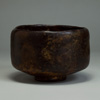
Black Raku tea bowl named “Kôtô”
 Tanaka Sôkei (1535 ~ ? ,age 60 in 1595)
Tanaka Sôkei (1535 ~ ? ,age 60 in 1595) -
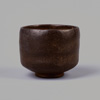
Black Raku tea bowl named “Isarai”
 Shôzaemon Sômi (date unknown)
Shôzaemon Sômi (date unknown) - Sômi was a son of Sôkei and a brother of Jôkei, the second generation.
His daughter is married to Chôjirô according to the document left by Sônyû dated 1688. Some works attributed to Sômi have survived but need further studies regarding the definition.
 Jôkei II ( ? ~ 1635)
Jôkei II ( ? ~ 1635) -
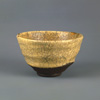
Ido type tea bowl with kôro white glaze
 Dônyû III (1599~1656)
Dônyû III (1599~1656) -
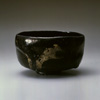
Black Raku tea bowl named “Zansetsu”
 Ichinyû IV (1640 ~ 1696)
Ichinyû IV (1640 ~ 1696) -
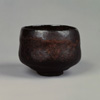
Black Raku tea bowl named “Kashin”
 Sônyû V (1664 ~ 1716)
Sônyû V (1664 ~ 1716) -
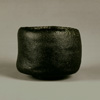
Black Raku tea bowl named “Kimô”
 Sanyû VI (1685 ~ 1739)
Sanyû VI (1685 ~ 1739) -
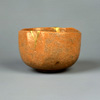
Red Raku tea bowl named “Tôri”
 Chônyû VII (1714 ~ 1770)
Chônyû VII (1714 ~ 1770) -
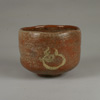
Red Raku tea bowl with Sacred Gem Design
 Tokunyû VIII (1745 ~ 1774)
Tokunyû VIII (1745 ~ 1774) -
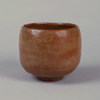
Red Raku cylindrical tea bowl
 Ryônyû IX (1756 ~ 1834)
Ryônyû IX (1756 ~ 1834) -
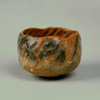
Red Raku tea bowl among a series of 70 red bowls produced at his 70th anniversary
 Tannyû X (1795 ~ 1854)
Tannyû X (1795 ~ 1854) -
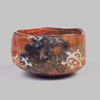
Red Raku tea bowl with Turtle Design done by the Lord Tokugawa Harutomi
 Keinyû XI (1817 ~ 1902)
Keinyû XI (1817 ~ 1902) -
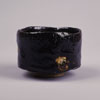
White Raku tea bowl named “Shiohi”
 Kônyû XII (1857 ~ 1932)
Kônyû XII (1857 ~ 1932) -
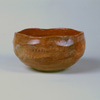
Red Raku tea bowl named “Kamese”
 Seinyû XIII (1887 ~ 1944)
Seinyû XIII (1887 ~ 1944) -
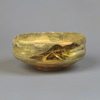
Tea bowl with Daimonji Design
 Kakunyû XIV (1918 ~ 1980)
Kakunyû XIV (1918 ~ 1980) -
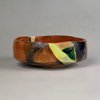
Red Raku tea bowl named “Sai-I”
 Jikinyū XV (1949 ~ )
Jikinyū XV (1949 ~ ) -
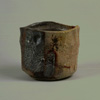
Black Raku yakinuki type tea bowl named “Hakuraku”

 Raku Kichizaemon XVI (1981 ~ )
Raku Kichizaemon XVI (1981 ~ ) -
Born the eldest son of Jikinyû. After He graduated from the Sculptural Department at the Tokyo University of the Arts in 2008, he learned fundamentals of ceramics at a training center devoted to fostering the city’s traditional industries. Then he went to Great Britain in 2010. He succeeded as the 16th generation Kichizaemon in 2019.
 Raku Related People
Raku Related People
 Hasegawa Tôhaku (1539~1610)
Hasegawa Tôhaku (1539~1610)- Hasegawa Tôhaku is a painter and founder of the Hasegawa school of Japanese style painting active during the Momoyama period. He was born in Nanao, a town in Noto province (present Ishikawa prefecture). After studying painting in his home province, he moved to Kyoto to develop his own individualistic style. He is particularly renown for his Ink and wash painting, bird and flower genre and portraits.
In 1595 he was commissioned by Tanaka Sôkei to produce a seated portrait of Rikyû (the collection of the Omote Senke), which shows that he was on friendly terms with the Raku family.
 Raku Dôraku (dates unknown)
Raku Dôraku (dates unknown) - Dôraku is a brother of Dônyû, the third generation. He is supposed to have worked in Sakai, making Raku tea bowls. It is said that he used the Raku reverse seal, but not clarified. The survived examples of tea bowls attributed to Dôraku are stylistically all varied with major inconsistency in the style of the seal used.
 Hon'ami Kôetsu (1558 ~ 1637)
Hon'ami Kôetsu (1558 ~ 1637) - Hon'ami Kôetsu was born into a prominent merchant family in Kyoto professionally engaged in the forging and connoisseurship of swords. He was a typical man of culture of his period, developing various cultural activities. In 1615 Kôetsu moved to a place called Takagamine in the northwest of Kyoto granted him by Tokugawa Ieyasu, where he started making Raku tea bowls assisted by Raku Jôkei II and Dônyû III. The letters written by Kôetsu have remained in the Raku family archive in which he asked them to prepare the clay or to glaze the bowls. Kôetsu tea bowls are renown for their spontaneity absent of stylistic restriction. His black Raku tea bowls are supposed to have been fired in the Raku kiln because of the similarity in glazing quality.
 Ichigen, the founder of Tamamizu ware (1662 ~ 1722)
Ichigen, the founder of Tamamizu ware (1662 ~ 1722) - Ichigen was an illegitimate son of Ichiniyû IV. He was raised in the Raku family until he was in late teens but later moved to Tamamizu village (present Idecho, Tsuzuki-gun, Kyoto), the hometown of his mother, and started Tamamizu ware mainly producing tea bowls. Some of these ware are marked with the Raku seal.
After the direct family line from Ichigen had ceased, the Tamamizu kiln went on operating till the end of Edo period but now it has ceased to exist.
Ichigen copied some of Ichinyû glaze such as shugusuri glaze and it is sometimes difficult to tell one from the other.
However stylistic characteristics between the two are quite varied, with a strong distortion and heavy trimming characterizing Ichigen's work.
 Ogata Kenzan (1663 ~ 1743)
Ogata Kenzan (1663 ~ 1743)- Born the third son of Ogata Sôken of Kariganeya, a textile-manufacturing family. His elder brother was Ogata Kôrin, a famous Rimpa school painter. He is a cousin of Sônyû V. He learnt pottery under Nonomura Ninsei. In 1699 he established the Narutaki kiln in Kyoto, continuing his pottery making in Edo in his later years.
In contrast to Sônyû's attachment to the style of Chôjirô inspired by Rikyû's wabi ideals, Kenzan established his unique style in colourful overgalze enameled pottery and produced numerous tea bowls with iron paint.
 450 Years of Raku-Yaki
Infinite Drama of Tradition and Innovation
450 Years of Raku-Yaki
Infinite Drama of Tradition and Innovation  Raku successive generations
Raku successive generations Ameya, the forebear (date of birth unknown)
Ameya, the forebear (date of birth unknown)  Chôjirô, the founder ( ? ~ 1589)
Chôjirô, the founder ( ? ~ 1589) 
 Tanaka Sôkei (1535 ~ ? ,age 60 in 1595)
Tanaka Sôkei (1535 ~ ? ,age 60 in 1595) 
 Shôzaemon Sômi (date unknown)
Shôzaemon Sômi (date unknown)  Jôkei II ( ? ~ 1635)
Jôkei II ( ? ~ 1635) 
 Dônyû III (1599~1656)
Dônyû III (1599~1656) 
 Ichinyû IV (1640 ~ 1696)
Ichinyû IV (1640 ~ 1696) 
 Sônyû V (1664 ~ 1716)
Sônyû V (1664 ~ 1716) 
 Sanyû VI (1685 ~ 1739)
Sanyû VI (1685 ~ 1739) 
 Chônyû VII (1714 ~ 1770)
Chônyû VII (1714 ~ 1770) 
 Tokunyû VIII (1745 ~ 1774)
Tokunyû VIII (1745 ~ 1774) 
 Ryônyû IX (1756 ~ 1834)
Ryônyû IX (1756 ~ 1834) 
 Tannyû X (1795 ~ 1854)
Tannyû X (1795 ~ 1854) 
 Keinyû XI (1817 ~ 1902)
Keinyû XI (1817 ~ 1902) 
 Kônyû XII (1857 ~ 1932)
Kônyû XII (1857 ~ 1932) 
 Seinyû XIII (1887 ~ 1944)
Seinyû XIII (1887 ~ 1944) 
 Kakunyû XIV (1918 ~ 1980)
Kakunyû XIV (1918 ~ 1980) 
 Jikinyū XV (1949 ~ )
Jikinyū XV (1949 ~ ) 
 Raku Kichizaemon XVI (1981 ~ )
Raku Kichizaemon XVI (1981 ~ )  Raku Related People
Raku Related People Hasegawa Tôhaku (1539~1610)
Hasegawa Tôhaku (1539~1610) Raku Dôraku (dates unknown)
Raku Dôraku (dates unknown)  Hon'ami Kôetsu (1558 ~ 1637)
Hon'ami Kôetsu (1558 ~ 1637)  Ichigen, the founder of Tamamizu ware (1662 ~ 1722)
Ichigen, the founder of Tamamizu ware (1662 ~ 1722)  Ogata Kenzan (1663 ~ 1743)
Ogata Kenzan (1663 ~ 1743) RAKU WARE | History
RAKU WARE | History